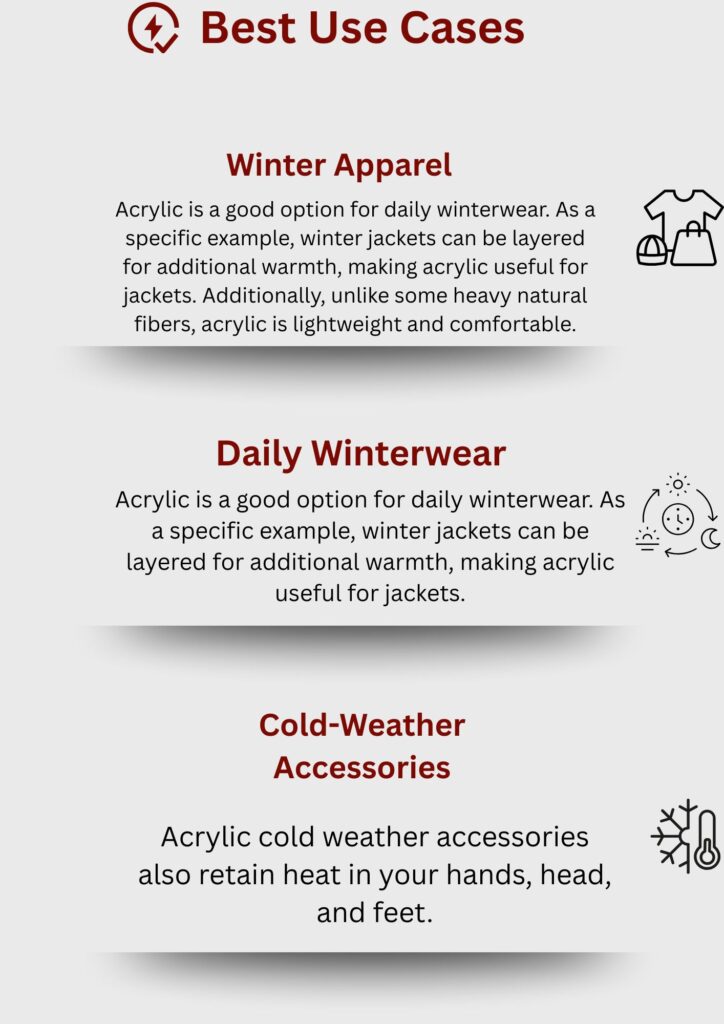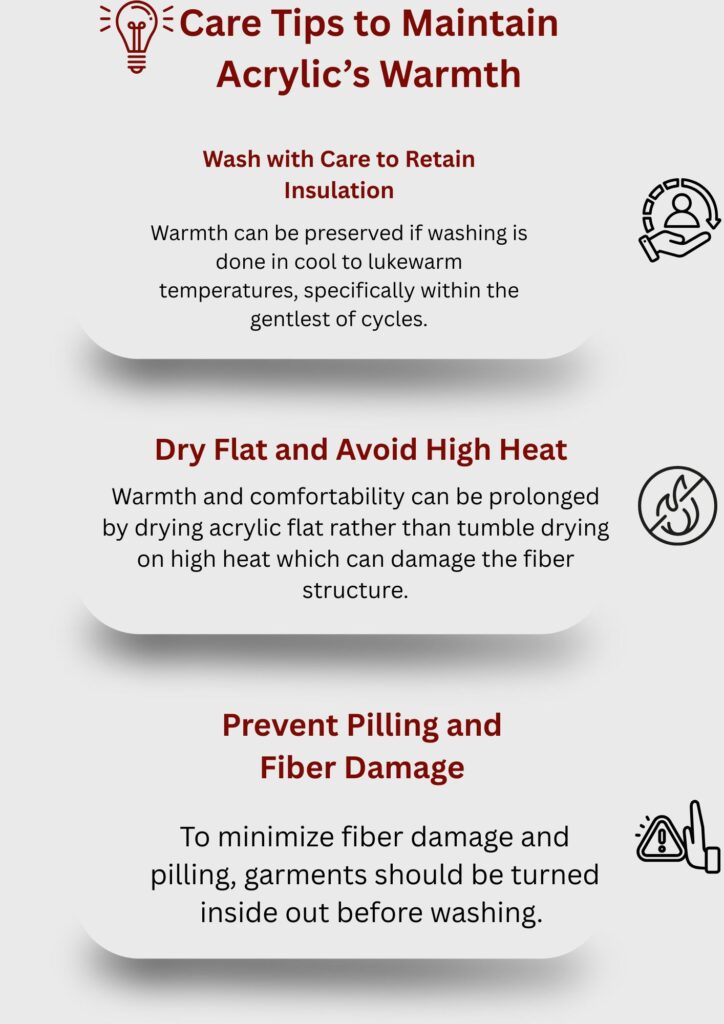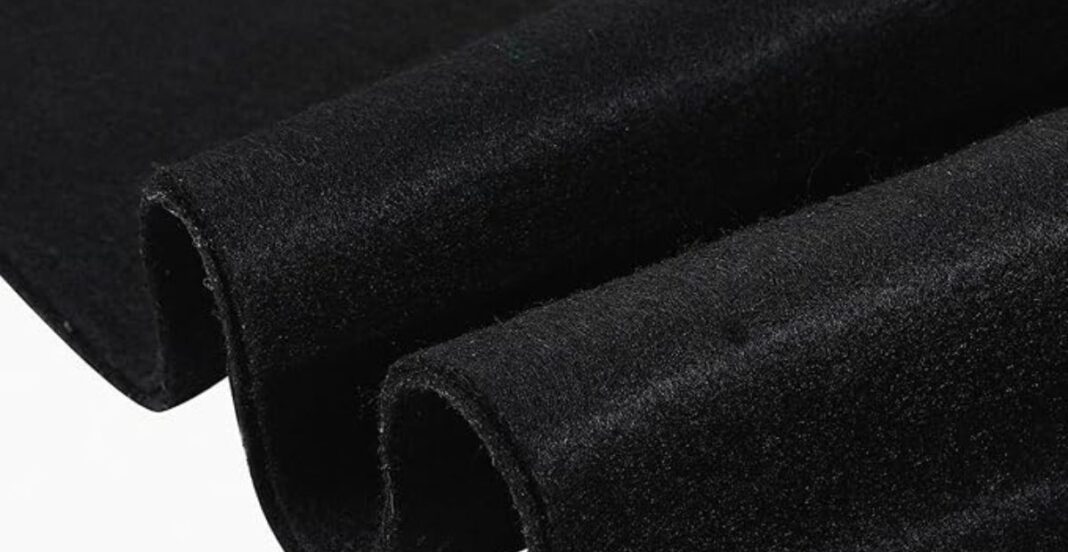Introduction
Acrylic is a popular synthetic fiber derived from the polymer acrylonitrile. Its fibers are soft and come in many colors, enabling easy imitation of wool. The synthetic fiber is readily available and adaptable, providing acrylic a regular place in everyday winter apparel.
You can find acrylic apparel in sweaters, scarves, socks, gloves, blankets, and even outdoor winter equipment. While the fiber can resemble wool in appearance, does it truly provide the same comfort and insulation that it claims to provide? In this paper, we will thoroughly examine the thermal properties of acrylic to assess its suitability in cold climates.
Is Acrylic Warm? – The Direct Answer
Yes, Acrylic Is Warm But Let’s Look Deeper
Acrylic is warm, especially during the cold seasons. One of the best qualities of acrylic is its ability to be warm. That said, the warmth that it provides varies with the manner of spinning, weaving, or blending it.
In comparison to natural fibers such as wool and cotton, acrylic is quite favorable regarding insulation. It does not easily absorb moisture and even retains some heat during reasonably cold temperatures. It is worth noting, however, that the warmth provided by acrylic does not come close to that of high-end wools such as Merino. Thus, acrylic provides warmth, even though it is not the warmest option out there.
How Does Acrylic Provide Warmth?
Heating Retention Due to Structure
The design of acrylic fabric contains air spaces that retain heat near the body, functioning as insulators. Due to air pockets, maintaining heat is easier even with lightly baked and lower weight garments. For this reason, acrylic is warmer even though it is not as thick as heavy wools.
Lightweight yet still warm
The warm retention of acrylic comes with no additional weight. This is particularly helpful during cold seasons as it is ideal for layering. In contrast to thick wool, acrylic does give the freedom of movement as well as warmth.
Between Other Synthetic Fibers
When evaluating other synthetic materials with acrylic such as polyester or nylon, it is surprising to find other fibers rank lower in warmth.Nylon does not focus on warmth like acrylic does, it focuses solely on thermal insulation, thereby making acrylic the warmest synthetic option.
Acrylic vs. Wool: Which Is Warmer?
Acrylic Offers Value, But Wool Wins in Warmth
The comparison of two knitted fabrics, acrylic and wool, shows that wool is preferable in warmth. Wool is superior in warmth as its fibers trap more air which is an advantage in freezing temperatures.
Comparison in Breathability and Moisture Control
Wool breathes better and wicks moisture better than Acrylic. Wool also helps keep skin dry, which in turn helps prevent the chances of catching cold. While Acrylic does keep a person warm, it might not breathe as well, therefore making it more unsuitable for outdoor physical activities in extreme cold.
Pros and Cons of Each Material
- Acrylic Advantages: Blue collar costs, Light in weight, does not trigger allergies, does not lose color, favors vegans
- Acrylic and Wool Disadvantages: Less breathe ability, More prone to lint, losing warmth when wet, expensive, allergy triggering, requires delicate cleaning
Best Use Cases
Best use of wool is for hiking, skiing and extreme cold. Wool is best suited for city life while light jackets, casual winter wear, and sweaters.

Daily Winterwear
Acrylic is a good option for daily winterwear. As a specific example, winter jackets can be layered for additional warmth, making acrylic useful for jackets. Additionally, unlike some heavy natural fibers, acrylic is lightweight and comfortable. It is wrinkle-resistant and holds shape well, making it easy to maintain.
Perfect For:
- Sweaters
Cardigans
Turtlenecks
Knit dresses
Cold-Weather Accessories
Acrylic cold weather accessories also retain heat in your hands, head, and feet. These accessories are useful for cold weather/snowy walks and brisk commutes as acrylic fibers retain warmth while also resisting moisture.
Perfect For:
- Beanies and hats
- Gloves and mittens
- Snoods and scarves
- Thermal socks
Home Blankets and Throws
Acrylic blankets are perfect for cold weather as well as soft and cozy for cuddling. They efficiently retain warmth and are machine washable. Moreover, vibrant colors and textured patterns add to home décor.
Perfect For:
- Couch throws
- Bedspreads
- Decorative winter blankets
- Heated electric blanket covers
Is Acrylic Good for Winter Clothing?
Everyday Winter Coats That Keeps You Warm
Indeed, acrylic is utilized in producing winter garments, including gloves, hats, sweaters, and throws. It is quite affordable in comparison to other materials, and ensures that its users remain warm during winter breaks or when moving indoors to areas that have moderate temperatures.
Strengths: Lightweight and Heat-Retaining
People who dislike wearing heavy layers find acrylic to be an excellent option as it is lightweight and retains heat well. Acrylic is also offered in multiple weaves and textures, thus easy to find cozy knits that will make you warm and match your comfort levels.
Weaknesses: Less Breathable, May Pill
But there are downsides; acrylic may not be as breathable as other materials, it may trap sweat. It is also prone to pilling, which will make its comfort and aesthetic appeal to decrease.
Does Acrylic Keep You Warm When Wet?
Loses Warmth When Damp
Compared to wool, acrylic loses some of its insulating power, especially when damp. It doesn’t absorb much water, but once damp, does not retain heat well.
This distinction is particularly important when considering extended use in snow or rain. Wool jackets may provide some insulation when dampened, but gas permable acrylic jackets with wool insulation provide no insulation when wet.
How It Compares to Cotton
However, in comparison to cotton, acrylic still outperforms in damp conditions. Cotton does absorb water quickly, but does not let go of it, making one feel chill and clammy. So while acrylic does not provide insulation flawlessly, it outperforms cotton, maintaining heat better in wet weather.
Is Acrylic Warmer Than Cotton?
Acrylic is Definitely Warmer
Acrylic is warmer than cotton in almost every situation. This is because cotton lacks the insulating air pockets that synthetic acrylic possesses.
Why Cotton Falls Short
Cotton fibers not only permit heat to escape readily, but it also absorbs moisture readily, towel-like, which cools you down. In the opposite direction, acrylic repels water and holds heat better, especially when dry.
Best Acrylic Blends for Maximum Warmth
Wool With Acrylic Blends For Warmth
Blending acrylic with wool offers a compromise as we receive hugs knitting wool gives, with the breathability from the wool, while the acrylic offers durability. Premium winter wear and upscale scarves tend to have these blends.
Acrylic Wool Blends For Sturdiness
A blended wool and polyester form warm outdoor apparel with an additional element of strength. Hence these blends tend to be fused with outdoor jackets, sportswear, and fleece materials. The additional strength and warmth make them desirable.
Common Misconceptions About Acrylic Warmth
Myth: Acrylic Is As Warm As Wool
Myth: The claim that wool and acrylic are of the same warmth is incorrect. Wool’s inherent insulating and moisture control features provide superiority over acrylic.
Myth: All Acrylic Is Itchy
Avoiding The Itchy Myth: The perception that all fabrics made of acrylic are scratchy is incorrect. While some fabrics definitely are, higher-grade acrylics do tend to have a soft and silky touch. The claim does hold when the brand is of low and cheap quality. So while checking for the harshness, make sure the brand and quality is appropriate.
Care Tips to Maintain Acrylic’s Warmth

Wash with Care to Retain Insulation
Warmth can be preserved if washing is done in cool to lukewarm temperatures, specifically within the gentlest of cycles. Hot water is not to be used as it can damage the fibers, while mild soaps should be used instead of harsh chemicals.
Dry Flat and Avoid High Heat
Warmth and comfortability can be prolonged by drying acrylic flat rather than tumble drying on high heat which can damage the fiber structure.
Prevent Pilling and Fiber Damage
To minimize fiber damage and pilling, garments should be turned inside out before washing. Stretching and pilling can be caused by hanging clothes, and therefore, acrylic clothes should be stored folded.
Environmental & Ethical Considerations
Is Acrylic Sustainable?
Regrettably, acrylics cannot be recycled and shed microplastics when washed, which poses a significant risk, especially to the ocean. But, there are innovations focusing on creating more eco-friendly acrylics which may resolve this problem.
Vegan-Friendly Alternative to Wool
Wool can be substituted by using acrylic as it is vegan and cruelty free. Ethical shoppers are able to turn to high-quality acrylic as it is a warm and affordable option.
Conclusion
So, Is Acrylic Warm? Yes — But With Conditions
Acrylic does indeed keep you warm, making it a follows practical option for winter outerwear. Moreover, it retains heat well, particularly when it is dry, considering it is lightweight and inexpensive. However, it is less warm than wool in wet conditions and extreme cold.
Acrylic is warm, inexpensive, and a viable option for layering. It works best when used in blends, providing cozy comfort and ease of wear during winter. It is a wonderful choice for comfort-seekers looking for vegan alternatives. Just like any other clothing, it has to be maintained and its limitations understood.
So, in this case, is acrylic warm enough for winter? Yes; its affordable nature is a bonus. However, for ultimate winter layering, wool remains the best option.


